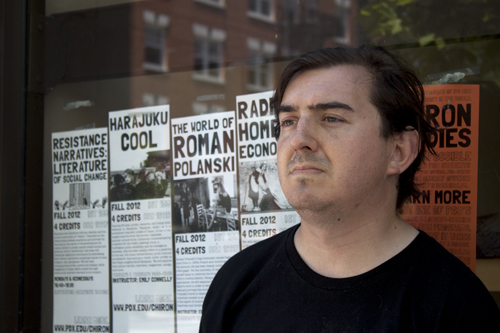“Cinematic genius—international playboy—tragic victim—immoralist. Which is the real Roman Polanski?”
This is the first sentence on the syllabus of Eric Wilkinson’s Chiron Studies course, called The World of Roman Polanski.
“Cinematic genius—international playboy—tragic victim—immoralist. Which is the real Roman Polanski?”
This is the first sentence on the syllabus of Eric Wilkinson’s Chiron Studies course, called The World of Roman Polanski.
“Cinematic genius—international playboy—tragic victim—immoralist. Which is the real Roman Polanski?”
This is the first sentence on the syllabus of Eric Wilkinson’s Chiron Studies course, called The World of Roman Polanski.

Set to start this fall, it will focus on Polanski as an artist—not the man accused of statutory rape. Currently, only one student is enrolled, perhaps because of the class’s controversial topic.
A few weeks ago, as Wilkinson was walking to one of his classes, he saw one of his fliers on the floor with the words “CHILD RAPIST” graffitied across the front. It wasn’t the only one.
“At first I was mad. I can’t say that I was shocked, but I was disappointed,” Wilkinson said. Afterward, he sat in a class but couldn’t focus, so he went out into the hallway to think things through.
“I just went out, and after I had a little time to let it soak in, I took the fliers down, tore them up and threw them away,” Wilkinson said. “I was disappointed that in a college setting it’s still possible for things to be vandalized rather than to start a dialogue.”
He explained that he would not have minded if people had put up posters next to his that said, “Don’t take this class,” or if people had created new fliers expressing their opinions of Polanski. “I thought graffitiing my fliers and leaving it like that was really uncool,” Wilkinson said.
Wilkinson then went to his faculty mentor, Sue Brower, an assistant professor in theater and film in the School of Fine and Performing Arts, and discussed his feelings with her. She explained that others have an opinion, he has an opinion, and that those opinions may differ, Wilkinson said.
“By vandalizing something instead of putting your opinions out there separately, you’re effectively trying to silence the opposing opinion, and not letting it speak for itself and disagreeing with it. You’re saying, ‘You don’t get the right to have this opinion,’” he said.
Brower also pointed out that academic freedom to study controversial subjects is protected and encouraged by the university.
“[Wilkinson] and I have discussed his plans for the course, and they include openness to all opinions from students in the class,” she said.
Right after the incident with the fliers, Wilkinson admitted that he felt like quitting. After thinking about it, he was more determined than he had been before.
“I’m assuming, and maybe it’s not a fair assumption, but I do know it’s out there, that there are preconceived notions about him because of the controversy in the press about him in the last couple of years,” Wilkinson said. “And I would like to challenge those preconceived notions and possibly change them, or at least have a dialogue about it.”
Wilkinson wants to help his students discuss Polanski as a whole and not focus only on a single part of his life.
“I want everyone to understand that he did something 35 years ago that was unbelievably wrong. He knows it was unbelievably wrong, and his ‘victim’ has forgiven him multiple times in the press. I don’t believe that actions 35 years ago, no matter what they are, should necessarily stand in the way of somebody’s artistic contributions.”
Diana Abu-Jaber, a professor in the English department, agrees. “I think Polanski is an important filmmaker whose work deserves to be studied,” she said.
“I want students to have an appreciation of Polanski as a film artist, first and foremost, because that’s what I think he is. I’d like them to have an understanding of where he comes from and his place in film history, world history, and his own history—how it all ties together,” Wilkinson said.
Abu-Jaber believes this class should be taught like any other film class. “I think [students] should get the same sorts of things from this class as from any course on a brilliant filmmaker: an in-depth look at story, pacing, mood, technique, his noirish sensibilities, his transgressive characters and so on.”
Wilkinson has proposed this class to the Chiron Studies committee twice, the first a couple of terms prior to the second. At first, the board had issues with the way Wilkinson presented the class and believed he had some contradictory statements in his syllabus. After fixing that, Wilkinson was able to present the class again and get it approved for the Fall 2012 term.
Now, Wilkinson is hoping that he can get enough people enrolled in the course so that he can prove his belief that this is a good and interesting class.
“If you’re interested in film analysis, a film student or not, I believe it’s an interesting subject and worth the time to investigate and create a dialogue about,” Wilkinson said. “I like to think that anyone with an opinion about him will want to sign up for this class so they can be challenged and learn more. I think being open-minded is part of what it means to be a student.”